The First Rose - Rosa 'Blanc Double de Coubert'
Saturday, May 19, 2007
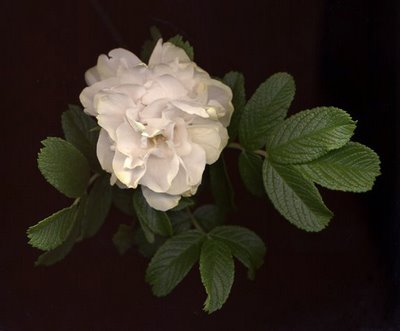 The two Maries were not taken to a ball until they were sixteen years of age, and then only four times a year in special houses. They were not allowed to leave their mother's side without instructions as to their behavior with their partners; and so severe were those instructions that they dared say only yes or no during a dance. The eye of the countess never left them, and she seemed to know from the mere movement of their lips the words they uttered. Even the ball- dresses of these poor little things were piously irreproachable; their muslin gowns came up to their chins with an endless number of thick ruches, and the sleeves came down to their wrists. Swathing in this way their natural charms, this costume gave them a vague resemblance to Egyptian hermae; though from these blocks of muslin rose enchanting little heads of tender melancholy. They felt themselves the objects of pity, and inwardly resented it. What woman, however innocent, does not desire to excite envy? The two Maries were not taken to a ball until they were sixteen years of age, and then only four times a year in special houses. They were not allowed to leave their mother's side without instructions as to their behavior with their partners; and so severe were those instructions that they dared say only yes or no during a dance. The eye of the countess never left them, and she seemed to know from the mere movement of their lips the words they uttered. Even the ball- dresses of these poor little things were piously irreproachable; their muslin gowns came up to their chins with an endless number of thick ruches, and the sleeves came down to their wrists. Swathing in this way their natural charms, this costume gave them a vague resemblance to Egyptian hermae; though from these blocks of muslin rose enchanting little heads of tender melancholy. They felt themselves the objects of pity, and inwardly resented it. What woman, however innocent, does not desire to excite envy? A Daughter of Eve (Chapter 1) by Honoré de Balzac -------------------------------------------------------------------------------------------------------------------------------- The first rose of the season in our garden (and I almost missed it) was Rosa 'Blanc Double de Coubert'. I didn't miss it because of its scent which is exactly like my mother's old Pond's Cold Cream. That first flower (there are over 25 buds) opened on Thursday and by the time I scanned it yesterday in the afternoon it was past its prime and the edges of this startlingly white rose were yellowish. But I like it as it is, reminiscent of my favourite flower that of the Magnolia grandiflora. I have been patiently waiting for Magnolia grandiflora to bloom since I planted the tree 12 years ago. Both flowers are equally fragrant if different in fragrance. Blanc Double de Coubert, sometimes called the muslin rose, came to my garden as an accident 18 years ago when I bought her in a North Vancouver nursery off Mountain Highway. I lost the label soon after and forgot about it. One day I noticed this tall bush with strange foliage. I had to look the rose up and once it bloomed I knew I had a hybrid rugosa. Rugosa roses are extremely hardy (Zone 3) as they originate in eastern Siberia, northern China, Korea and Japan. Rugosa refers to the beautifully crinkled leaves. What is special and extraordinary about rugosas (most are extremely fragrant and have very nice hips, except for Blanc Double de Coubert) is that they are disease free and actually resent being sprayed with anything. They are remontant, which means that they bloom most summer and into fall. For potential rose gardeners who may be intimidated by the apparent complexity of rose pruning, Blanc Double de Coubert is never pruned. I leave it alone. My Blanc Double de Coubert is also shade tolerant. At 11 ft high she is tall and elegant. 19th century British gardener Gertrude Jekyll (rhymes with treacle) wrote that Blanc Double de Coubert was the whitest white of any flower. I would argue that the white (and also fragrant) flowers of my Hosta plantaginea are as white. By coincidence Hosta plantaginea is the only species hosta with fragrant flowers. Blanc Double de Coubert was hybridized in 1892 by Frenchman Cochet-Cochet who lived in Coubert. He said it was a cross between the species rose Rosa rugosa and the tea rose Rosa 'Sombreil'. Nobody really believed him and most suspect that Blanc Double de Coubert might be a sport (mutation) of Rosa rugosa 'Alba'. As I scanned my first rose yesterday its perfume filled my living room. That perfume reminds me that late May may be the best month in the garden. You can notice how plants grow from one day to the next. My hostas have no slug holes and look pristine. The buds of my roses will soon fulfill their promise. 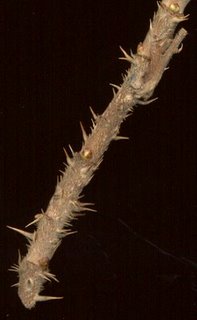 But Blanc Double de Coubert has one "flaw". Like all rugosas its stems have extremly thin and sharp spines. If you don't handle this rose with gloves the spines get into your fingers and break off. They are extremely painful.
The Ramans Do Everything In Threes
Friday, May 18, 2007
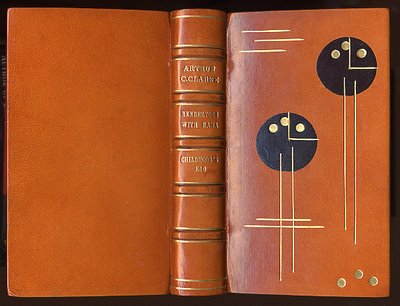 My Tía Fermina 95, lies very sick in a Houston hospital. She has a degenerated mitral valve in her heart that has precipitated a double pneumonia. She is too old for an operation and the medication to control the failed valve is not working. Her family called in the priest who gave her Communion and Extreme Unction. He jokingly told her that if she waited for another five years the statute of limitations on the sacrament (not true!) would enable him to return and give her the holy oils again. This seemed to perk her up and while she had had a doughnut for breakfast yesterday morning by lunch time she was demanding food from her favourite Vietnamese restaurant. Food with my aunt has always been the indicator of her health. It was on Wednesday that one of her daughters, Chayo had written to me, "Unfortunately since Thursday of last week she started sleeping a lot and not eating, not even chocolates!!!!" I was able to talk to her yesterday. She was deaf so our conversation was one-sided. She floored me when she told me that we were in her prayers specially now. It made me think of my mother was was nickanamed Sarah Bernhardt because she over-acted her health troubles. We thought she was hypochondriac. But in the late 50s she was diagnosed with Meniere's (I believe it is still incurable) which attacks the inner ears. It begins with loud buzzing sounds that destroy the body's balance mechanism so that one is constantly dizzy with almost a constant nausea. And yo become deaf in spite and because of the loud ringing in the ears. By the late 60s my mother was in despair and she confessed to me that she was losing her faith in a God that interceded in human affairs. He was aloof and thus prayer had no value. I was hard-pressed to convince her that she was wrong. The reason is that my loss of faith had been precipitated by Arthur C. Clarke's science fiction novel, A Rendezvous With Rama. A huge craft is detected approaching the solar system.  It parks outside and then approaches the Sun. Earthlings investigate the craft but find nothing of the would be pilots. They find out that the craft, on its way to somewhere else, has "gassed up" with hydrogen from our sun. We humans are no more important that a gnat. The novel left me with a feeling that may have been the same one when Copernicus revealed to his world that the earth was not the centre of the universe and that the sun did not orbit the earth but the other way around. My mother showed no surprise when I told her of the book. In the early 70s I had Rendezvous With Rama bound together with that other favourite Clarke novel Childhood's End. The French book binder Millioud had a shop in Mexico City and his work was legendary. He never scoffed at the idea of binding my cheap pocket books. When he returned this book he told me it was his interpretaion of Clarke's novel. It did not register on me at all and I just mentioned how lovely the cover was. It was only this morning that I caught on. Millioud must have at least read the last few sentences of Rendezvous: And on far-off Earth, Dr. Carlisle Perera had as yet told no one of how he had wakened from a restless sleep with the message from his subconscious echoing in his brain: The Ramans do everything in threes.-------------------------------------------------------------------------------------------------------------------------------- Tía Fermina is better today and her daughter Carmencita is now worrying of the problem of finding an extended care facility for her. I warrant that the priest will not be called for another five years. 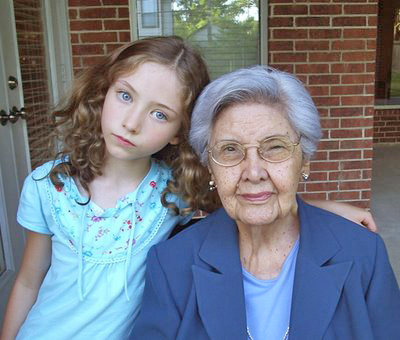 Here is Tia Fermina with Rebecca. I took this photograph last year when we visited her in Houston on our way back from Morelia. I think we need her to keep praying for us.
Hers & Mine
Thursday, May 17, 2007
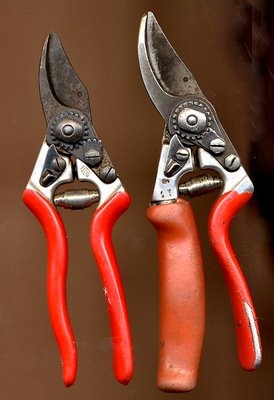 A garden without tools would never be much of a garden. In our 21 years of gardening at our Athlone home, Rosemary and I have spent lots of money on tools, some useful and some useless, some that didn't work, plus a small fortune on all kinds of spades whose handles I managed to break just about every year. In one case I broke the stainless steel blade. Yesterday I paid $36 (a bargain) on a spade at Lee Valley Tools that comes with a lifetime guarantee. A good spade is absolutely necessary if you transplant big hostas or move roses the way Rosemary and I do. Whenever we make a final decision on where a plant should be, it doesn't take long before we change our mind. I have had the idea of mounting wheels on some of my big hostas and then I would move them around without a problem. For years I had been eying my Hosta 'Green Fountain' noticing it was in the wrong place. This plant has longish dark green leaves that cascade down. In the hosta bed with hostas that are vase-like, that are able to compete with agressive Osmunda regalis (Royal Ferns) and large clumps of white astilbes, this potentially beautiful plant was at a disadvantage. So yesterday with my new spade I took it out of the ground and put it into a big pot. I placed the pot on a pedestal in the back of my hosta bed. Alas, Green Fountain collapsed on the spot. But this morning it was all up again and I felt happy I had purchased the new spade to replace the "very good" one I broke last week. There is one tool that I have had for many years (a birthday present from Rosemary) and I would never think of going into the garden without it in my back pocket. These are my Swiss-made secateurs. They are a top of the line model that have a revolving handle to ease the strain on the hand when one is at it all day. These clippers I use to remove the leaves that might have black spot in my roses. I use it to prune the roses and all the rest of the bushes in my garden. I use them for jobs they were not intended to perform such as removing weeds from the lawn. I plunge the secateurs into the ground and twist around the ofending weed and pull out. Some years ago I learned to use a thick leather glove in my left hand. One morning I had noticed that my secateurs needed sharpening but I decided to skip the operation. I was cutting some branches (so as to then mulch them with more ease) while talking to Rosemary. I almost severed my thumb except for factors. The unsharpened blade (one important factor) met the resistance of my thumb nail. I bled a lot and learned my lesson. You see here our two Felco secateurs. Hers and mine. Hers are a bit rusty as Rosemary tends to leave them out in the rain and I have to bring them in. But she did point out a week ago when she used my pair, "Yours don't cut as well as mine do." I am so glad that is true.
Kimberly
Wednesday, May 16, 2007

Kimberly was the kind of woman who would look at you in the eye and ask you, "Are you happy?" right out of the blue. It was unsettling.

So was her face. After looking at these negatives I remembered that she was a bit ashamed of her manly hands. Looking at them here I think they are beautiful and no doubt that they are strong, too.
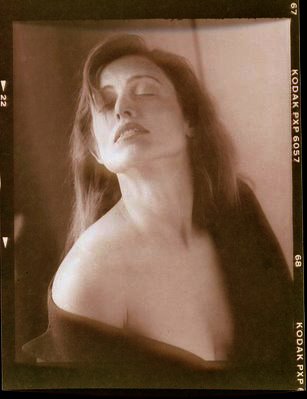

A Study in Blue
Tuesday, May 15, 2007
 Just about everybody remembers Newton's experiment with white light shining through a prism and fracturing to red, orange, yellow, green, blue indigo and violet. Few today know that panchromatic b+w film, colour film, video and digital sensors, while sensitive to those colours, are sensitive with a shift towards the blue. Humans shift towards the red which is why red is so much more visible to us and fire engines are red except in Surrey, BC where they are lime green/yellow. This is why people argue about turquoise. Some will swear it is more blue others will say it is more green. We can always agree on red but with the blues there will always be doubts. In the plant kingdom few flowers are a true blue. Blue hosta leaves are bluer to cameras, be they digital or film because blue hosta leaves reflect lots of ultra violet a colour that we humans cannot see. And since blue hostas are usually in the shade, there is more blue light (and UV) in the shade. Many blue flowers that we think are blue photograph as lilac or violet. Perhaps one of the only really blue flowers is the blue Himalayan poppy, Meconopsis grandis or Meconopsis betonicifolia. This incredibly difficult plant to grow (it loves dappled shade, rich and acid moist soil all features of Vancouver gardens yet.....) was introduced to Vancouver by our Blue Poppy Lady A.K.A Marion McDonnell. 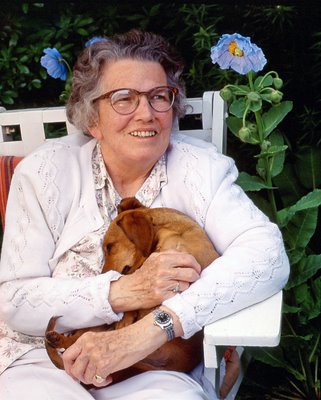 She was a most welcome fixture at the mostly rainy yearly VanDusen plant sales where in her plastic rain bonnet she would hand eager (and overly optimistic gardeners) her blue poppies which she grew from seed. Depending on the day she would either say they were Meconopsis grandis or Meconopsis betonicifolia. I failed to ever have one of my many plants repeat from one year to another. Here you can see Marion Mcdonnell in her garden with her beloved poppies and her Gretchen. Her good friend "Cookie", A.K.A. Alleyne Cook picked his "bluest" Rhododendron augustinii and named it as the cultivar ( a selected plant from a garden) Rhododendron augustinii 'Marion McDonnell'. By strict botanical nomenclature rules this cultivar would then be called only Rhododendron 'Marion McDonnell'. Last week I photographed Rebecca in front of my Rhododendron augustinii 'Marion McDonnell' and as you can see that while it is very beautiful it is not really blue. It is located not far from where I photographed Rebecca a few years ago holding the flower of Hydrangea macrophylla 'Blue Wave' which really is blue to the eye but not as blue to film. 
Indiana Luna - Supreme Elegance
Monday, May 14, 2007
 Indiana is close to 6ft tall and for a while she was my tango partner. Nobody ever seemed to want to dance with her because she was so tall. But I had noticed a couple of advantages. She liked to dress in black with black pumps and dresses that had slits in the right places. When I danced with her nobody seemed to notice me (that was just fine). Because of her height, and in order to dance Argentine tango style, which means awfully close, I had to rest my head on her chest. If you consider that Argentine tango is the only dance form where you might be slapped for not dancing close enough you can imagine the benefits of dancing with Indiana. The first time I met her, at a Latin Dance Café she introduced me to her husband and minutes later to a woman who was wearing an exquisite slicked back short haircut. This was her wife. 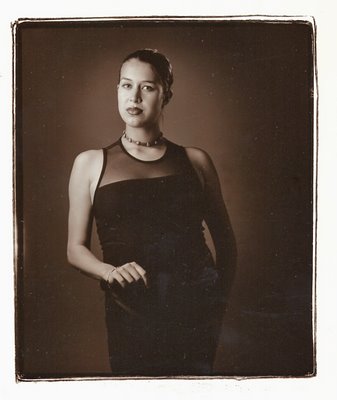 I mentioned to Indiana that in Canada it was called bigamy but she only shrugged it off with a laugh. Two days before having her first baby, Indiana came to my studio and posed for me. She brought her black tango outfit. 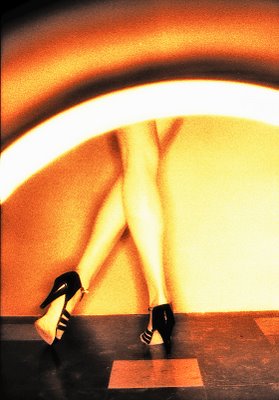 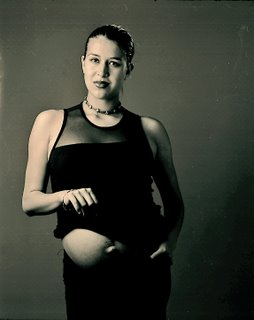
The Love Of A Mother
Sunday, May 13, 2007
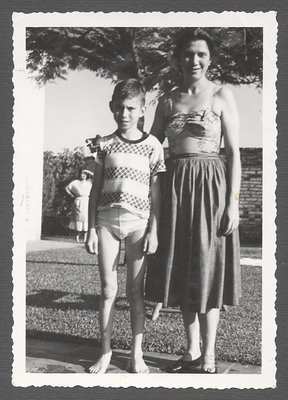
My mother often told me, "You will never understand because you will never be a mother." While I never felt (as a young boy) that I was a girl confined to eternity in a boy's body, my mother did make me curious as to what I may have been missing or avoiding.
She told me that love was doing and giving more than kisses and hugs. She sacrificed most of her life to sending me to good schools and satisfying my expensive tastes for smuggled Erector sets. Even when we could not afford it we had lots of the best food at the table. But she did mention to me a few times that I was "arisco". This is a Spanish word (that came via the Portuguese and the gallegos of northwestern Spain and has as its etymology the word arsenic) that really has no proper translation. The word is used to describe animals (specially horses) of unpredictable nature whom you would not pet (or in the case of a horse not ride). I can only hold my female cat Plata for about 25 seconds. After that she will scratch. She is "arisca" and will sleep on top of me during the night only because she chooses to do so.
My mother was never able to understand why I showered my father with kisses and hugs but kept my disance from her. I regret to admit that I may have told her that, "love could not be forced."
In 1954 my mother, my grandmother and I moved to Mexico. My grandmother had previously told me that I had to choose between my father and my mother. I was quick to answer (I was 11) that I wanted to stay in Buenos Aires. All the questionable legal proceedings to take me out of the country without the necessary permission of my father were taken and we arrived 19 July, 1954 in Mexico City.
I returned to Argentina in 1965 to comply with my obligatory conscription in the Argentine armed forces. Both my mother and I knew (but we never talked about it) that I was returning to search for my father. Shortly after I left she wrote me a poem, "Ruegos" which loosely translates as pleas.
México Sept 1, 1965
Alex
Ruegos
Puede ser que vuelvas,
Puede ser que no
Pero quiero que sepas
que aquí estaré esperando
noticias de ti
De vez en cuando.
Te deseo lo mejor
que la vida pueda brindarte
una carrera brillante
Una mujer para amarte
Como tu te mereces.
Por todo esto - hago preces.
Hijo mío, que Dios te bendiga
Que la Virgencita te proteja
Para que siempre te conserves
Bueno, ecuánime, integro
Todo esto y mucho más te deseo.
F.I.G. (Filomena de Irureta Goyena)
In the poem my mother had doubts that I would return. But I did return a year later (while still in the Argentine Navy) as I had managed to get free passage in an American C-130 Hercules to Panama and from there I wangled passage to Mexico City. In the picture here with my mother I am wearing an Argentine bespoke three piece flannel suit and I have my short military haircut.
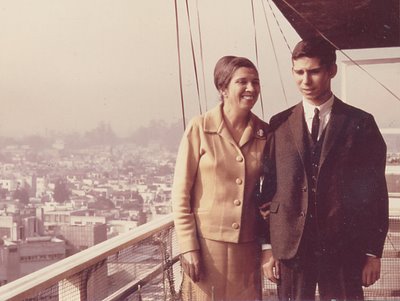
My mother may have been surprised to see me. But it was then that she told me something that I have treasured since with mixed emotion.
"As a mother I have always loved you because a mother has no choice. But I never did like you. Somehow you have changed and I like you now."
I think that is when we became friends.
|

























